The Friendly Fire Room Presents
Listen And See
Thank you Wanda Barlow for this great idea!
Pronouns Metaphors Errors Pt 10
Pronouns Metaphors Errors Pt 10
To God be the Glory, great things He has done.
mcmtffr.org wishes to acknowledge and thank Derek Konofalski and Rocket Media for making this page:
Mobile Friendly
Pronouns Metaphors, And Errors
Message
December 14, 2014
Part 10
OK, Let’s get started.
Our text is from the New Testament, Galatians 4.22-26.
Thus far we know that we are dealing with a complex allegory written by the Apostle Paul to believers.
22 For it is written that Abraham had two sons: the one by a bondwoman, the other by a freewoman.
23 But he who was of the bondwoman was born according to the flesh, and he of the freewoman through promise,
24 which things are symbolic. For these are the two covenants: the one from Mount Sinai which gives birth to bondage, which is Hagar --
25 for this Hagar is Mount Sinai in Arabia, and corresponds to Jerusalem which now is, and is in bondage with her children --
26 but the Jerusalem above is free, which is the mother of us all.
We begin by reviewing the relationship between the various elements of Paul’s continuous metaphor (allegory) .
As you have already seen, from the way this is beginning to unfold, if we are going to benefit from the questions and answers prompted by a careful reading of this text, we do well to orderly map out all information as it unfolds to us.

One of the things that make allegories so difficult to follow is that the metaphor figure and the thing it represents are both real things; unlike, for example, the fable, in which a rock might speak, and even carry on a conversation with a tree.
Because of the complexity of this text, you can easily see how the “reality” of the metaphor and the “reality” of the thing represented might become confused, resulting in a blurring of roles, creating an opportunity for gross misinterpretation of the biblical text to take place.
If you look at the handout, I will try to explain what is going on here.
First, in the main, there are four vertical columns, three of which have their origin in Abraham, and one origin in Moses.
As you know, a metaphor always defined by one real figure representing another real figure, where both figures are identified by name.
Although the representation corresponding to the figures of Abraham and Moses are not explicitly identified, we have no trouble getting it.
Whereas Abraham received God’s unilateral promises at face value, as-is, where-is, making it a unilateral covenant; the people receiving God’s unilateral promises through Moses, added their vow, their own personal promise to keep all the stipulations in their own strength, thereby effectively changing, mutating, altering, adapting, amending, modifying,… that one into a bilateral covenant.
Paul placed the whole of the metaphorical figures into a vertical relationship, that holds to a truly literal relationship as one proceeds downward:
| Abraham> Sarah> Free-woman> Promise-born> Isaac(Free) |
Abraham> @God in Heaven> Jerusalem Above> Uni-lateral Covenant> Free(Individual). |
Paul placed the metaphors and their representations in a horizontal relationship with one another.
From that we can picture the representative correspondence between each element:
Sarah=@God in Heaven,
Free-woman=Jerusalem Above,
Promise-born=Uni-lateral Covenant,
Isaac=Free Individual.
Paul placed the whole of the metaphorical figures and their representations into a single container, and told us to think about the entire contents as a homogenous mixture, which is one big allegory.
His purpose was to warn us to not get into trouble by confusing the vertical with the horizontal such that we might misinterpret some part of the literal vertical elements by evaluating them as a having a metaphorical relationship value, nor incorrectly read into some horizontal relationship a literal value.
For example, Sarah in her vertical relationship with the notion of a Free-woman is not a metaphor representing a Free-woman, and the notion of a Free-woman in her horizontal relationship with a Jerusalem Above is not a literal statement of fact.

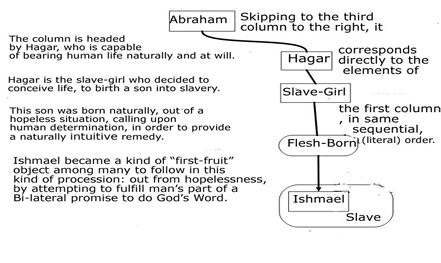
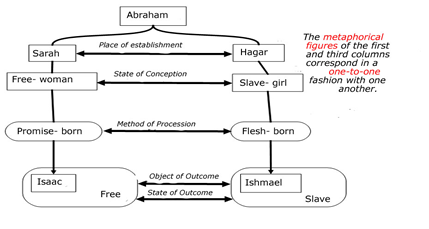
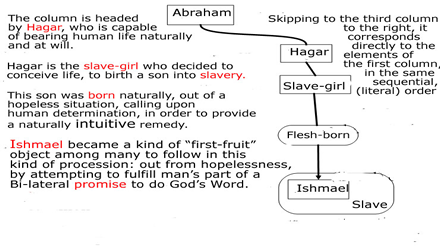
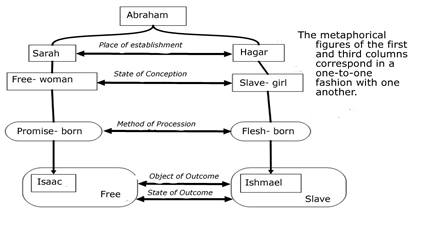
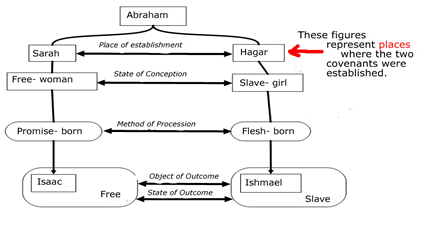
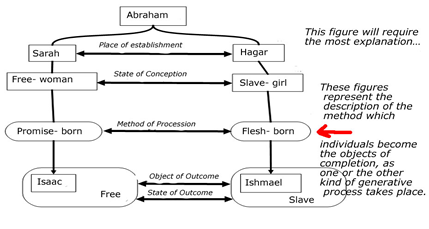
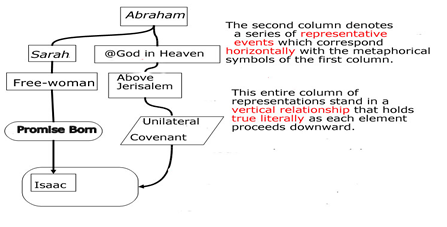
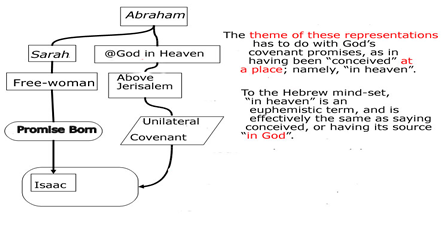
We need to stop here and pick up again next time in order to finish the presentation of this column; then we will deal with an explanation of all the relationships along with their implications and examine the practical applications to us personally.
Many will be surprised on the Day of Judgment
when they discover
that it was just as the Word of God says;
only the righteousness of Christ is able to save you.All men are sinners and no one can save himself.
God is just, so He must punish sin;
but He is also merciful, moreover gracious,
and offers His Son as the perfect sacrifice
in order to purchase a place for you in heaven,
which He offers to you as the free gift of eternal life.Jesus is the Christ, the Messiah,
the Anointed One, He is God Incarnate.
In order to pay the debt of our sins,
He came from Heaven, having been sent by the Father,
where He lived a life of perfect obedience to the Father
even unto the shameful death upon the cross
in order to pay the debt of your sins.This gift must be received by faith,
believing that Jesus’ perfect life and Cross Work
was His complete and necessary Atonement
for your sins, in your behalf.
Faith is a gift that comes by the Power of God the Holy Spirit working in a person’s innermost being.
Only the power of God can open your heart to the willingness to have the void within it filled
with the presence of Christ by His Spirit.The Holy Spirit has the authority and power to quicken your dead spirit, to make it come to life.
Only the life of His Spirit’s quickening of your heart will allow the Gospel message of salvation to even make sense to you, to truly “hear” the message and give you the ability,
as the Holy Spirit bears witness to Jesus,
to recognize your need for forgiveness and restoration, and gain the desire of your heart to be favorably inclined to want to receive Christ as your personal Lord and Savior.If you have not done so before this moment,
ask Jesus to forgive you your sins,
tell Him you’ve stop trying to be your own savior,
and ask Him to come into your life right now,
and to give you eternal life. Then, in faith believing,
thank Him for the gift that He is giving you,
the one He paid for in full in your place,
in Jesus’ name,
AMEN
Copyright December, 2014
Rev. Jim Craig
All Rights Reserved
Bibliography
Agnes, Michael and Charlton Laird (eds.). Webster’s New World Dictionary and Thesaurus. New York, NY: Macmillan, 1996.
Aland, Kurt, Matthew Black, Carlo M. Martini, Bruce M. Metzger, and Allen Wikgren (eds.). The Greek New Testament, 4th rev. ed. Germany: Biblica-Druck, 1994.
Benner, Jeff A. The Ancient Hebrew Lexicon of the Bible. College Station, Texas: Virtualbookworm.com Publishing Inc., 2005
Bullinger, E. W. Figures of Speech Used in the Bible; Explained an Illustrated. Grand Rapids, Michigan: Baker Book House, 2007.
Chapman, Benjamin. Greek New Testament Insert. Grand Rapids, Michigan: Baker Book House, 1977.
Dana, H. E., and Julius R. Mantey. A Manual of the New Testament. Canada: The Macmillan Company, 1957.
Louw, Johannes P. and Eugene A. Nida. Greek-English Lexicon of the New Testament Based on Semantic Domains. New York, NY: United Bible Societies, 1989.
The ESV Study Bible. Wheaton, Illinois: Crossway, 2011.
Metzger, Bruce M. Lexical Aids for Students of New Testament Greek. Princeton, New Jersey, 1977.
Wikipedia contributors. "Xenophon." Wikipedia, The Free Encyclopedia. Wikipedia, The Free Encyclopedia, 15 Aug. 2014. Web. 19 Aug. 2014.
Wuest, Kenneth S. The New Testament; An Expanded Translation. Grand Rapids, Michigan, 1992.
Wuest, Kenneth S. (Revised, Donald L. Wise). The Practical Use of the Greek New Testament, rev. ed. Chicago, Il: Moody Press, 1982.
Walsh, J. Martyn and Anna Kathleen Walsh. Plain English Handbook: A Complete Guide to Good English, 7th rev. ed. Cincinnati, Ohio: McCormick-Mathers PublishingCompany,1977.